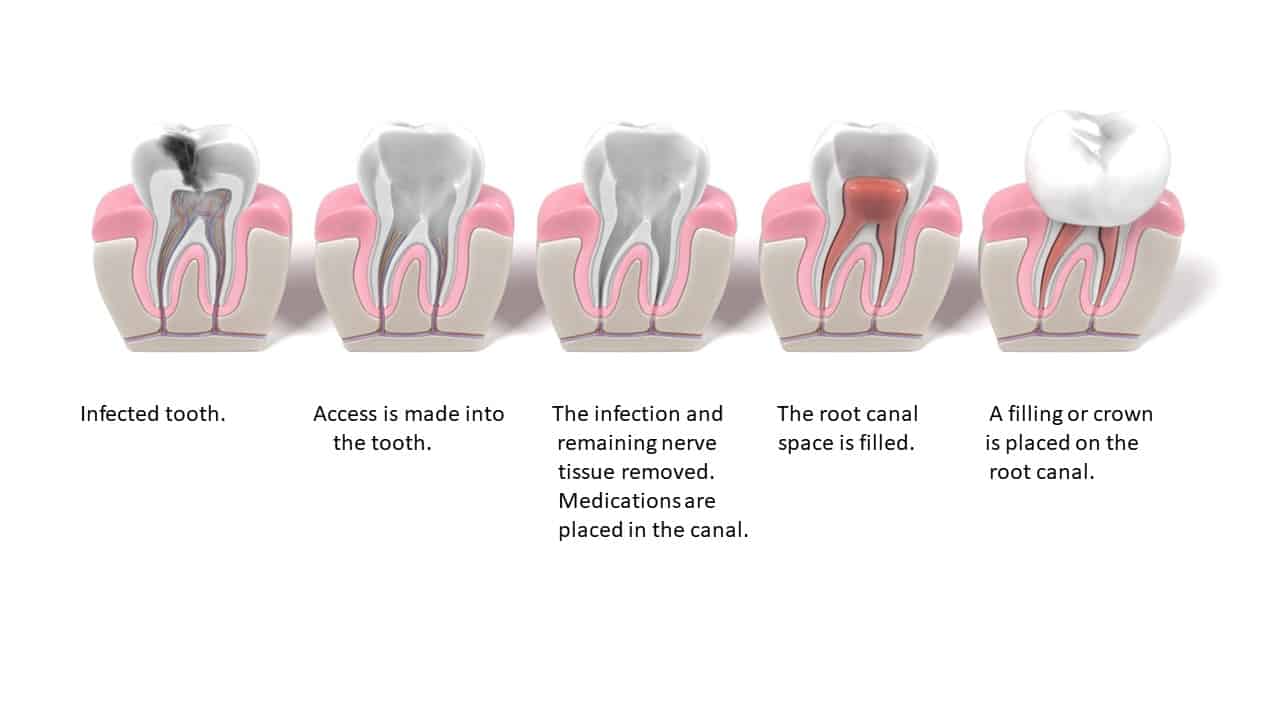
Root canals
Root Canal treatment (endodontic treatment) is the method used to keep your tooth when your tooth has died. The alternative option is to extract the tooth.
What causes a tooth to die?
Teeth have a very fine nerve network inside the tooth which is why you feel hot and cold temperatures in your teeth. Sometimes the nerve may die and then go into develop an infection if left untreated. Reasons for the nerve to die include:
- Trauma – the tooth has had an accident
- Dental decay (dental caries)
- A history of large fillings
- The way the tooth has developed
- Infection
- Breaking or fracturing the tooth
- Fine cracks in the tooth
- Occasionally the nerve can die for no obvious reason
Symptoms
You will often get symptoms, these can come and go as the nerve progresses through dying to developing an infection. The symptoms include:
- Pain – usually quite severe and may wake you at night or require pain killers. The pain is often long lasting.
- Swelling or a lump
- Tenderness and sensitivity
- Discolouration – If you have had trauma to the tooth it may become discoloured.
Sometimes there are no symptoms at all and infection may be found by your dentist on examination or on x-ray.
Treatment
When you visit us we will perform a series of tests and take an x-ray to establish if the tooth requires root canal treatment.
Treatment usually is over a series of 1-3 visits. Firstly a small access is made into the nerve structure using local anaesthetic.
A plastic sheet called a rubber dam is usually placed over the tooth to help isolate it and keep it clean and dry, as getting it clean is the aim of the root canal treatment.
The dead nerve and infected tissue is removed using very fine files to clean the nerve canal. It is washed with medication and dried. A medicated dressing is used and left in the canal between appointments. This medication may require replacement over additional appointments until the infection has cleared, the nerve canal is clean and the pain has gone.
You may need antibiotics and pain relief until the symptoms are resolved.
When the root canal is clean and dry a rubber based material called gutta percha is then placed in the nerve canal to seal the canal and a filling placed on top. It is often recommended that the tooth is also crowned with a ceramic or gold crown to provide strength and a good seal around the root filled tooth.
Complications of root canal treatment
Root canal treatment has several known complications. These include:
Failure to access the canals – sometimes we just can’t get into the nerve. If the tooth has been dying for a long period of time it tries to protect itself by laying down more tooth tissue and shrinking the canal. This can make the fine canals even harder or impossible to access to clean.
Failure to remove all the infection – the nerve is a fine spiderweb like network inside the tooth. The aim of the treatment is remove the nerve and any infected material. However – it is impossible to access all the fine parts and this can re-infect.
Infection is often outside the tooth itself in the bone. We cannot access this area with root canal treatment. If this infection does not resolve following treatment you may need to have this surgically removed by a specialist.
File separation – the files we use are incredible fine and delicate. These are manufactured under strict conditions. However, files can separate when using them, leaving small parts of the file in the canal. These can be sealed into the canal but do have a risk of re-infection, particularly if it occurs early in the treatment.
Perforation – sometimes one of the nerve branches exit at the side of the root rather than the end of the root. As we follow these down it can create a perforation or hole in the side of the root of the tooth.
Tooth Fracture – Often the tooth is already weakened from previous fillings. By creating an access to the nerve canal we must remove tooth tissue, weakening the tooth further. In between treatment the tooth must be treated very gently, avoiding using it while eating as it is weak and unprotected. Following treatment a restoration such as a filing or crown is placed. This will improve the strength of the tooth but it is still weak. The tooth can fracture resulting in having to extract the tooth.
The tooth may darken – the material used to fill the tooth is known to stain the tooth.
Prior to, and at any stage during the procedure we may need to refer you to an endodontic specialist as we simply do not know what we will find when we open the canal and begin the procedure.
Although there sounds like a lot of risks – root canals are generally very successful and allow you to keep the tooth for a long period, rather than extracting the tooth.

Stoke Location
Mapua Location
575 Main Road Stoke Nelson
Mapua - One Dental
66 Aranui Road
Maupa
Tasman 7055
035403440
office@onedental.co.nz


 Phone
Phone